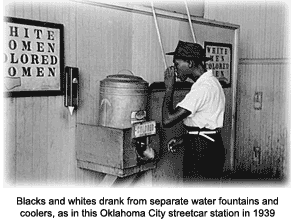The landmark 1896 U.S. Supreme Court decision, Plessy v. Ferguson, upheld racial segregation. In the case, the Supreme Court ruled that an 1890 Louisiana law mandating "separate but equal" facilities for whites and blacks on and near railroads was allowable.
In 1892, passenger Homer Plessy refused to sit in a "Jim Crow" (blacks only) car and was promptly arrested. He was brought before the Criminal Court for New Orleans, Judge John H. Ferguson presiding, who affirmed the state law. The case reached the Supreme Court, where the law was challenged on grounds that it contradicted the 13th and 14th amendments to the Constitution (text).
 The court ruled, by a seven to one vote, that a state law that suggests a simple legal distinction between the two races was not inconsistent with the 13th Amendment, which prohibits involuntary servitude. The court also held that passenger Plessy was not stripped of equal protection of the law under the 14th Amendment, if the facilities were separate but equal; according to the 1896 court, separate was not unequal. The notion remained in effect and slowly expanded into other social sectors for nearly 60 years.
The court ruled, by a seven to one vote, that a state law that suggests a simple legal distinction between the two races was not inconsistent with the 13th Amendment, which prohibits involuntary servitude. The court also held that passenger Plessy was not stripped of equal protection of the law under the 14th Amendment, if the facilities were separate but equal; according to the 1896 court, separate was not unequal. The notion remained in effect and slowly expanded into other social sectors for nearly 60 years.
During the 1950s and 1960s, racial integration of public schools became a major educational issue in the United States. Most schools in Southern states were racially segregated by local or state laws. In the North, local attitudes and neighborhood separation of the races resulted in numerous schools that were segregated in reality, but not in legal terms, i.e. de facto segregation. The doctrine of separate-but-equal facilities was applied by degrees to schools. However, in the case of Brown vs. Board of Education of Topeka (1954), the Supreme Court reversed the 1896 decision. The court ruled that "separate but equal facilities are inherently unequal."